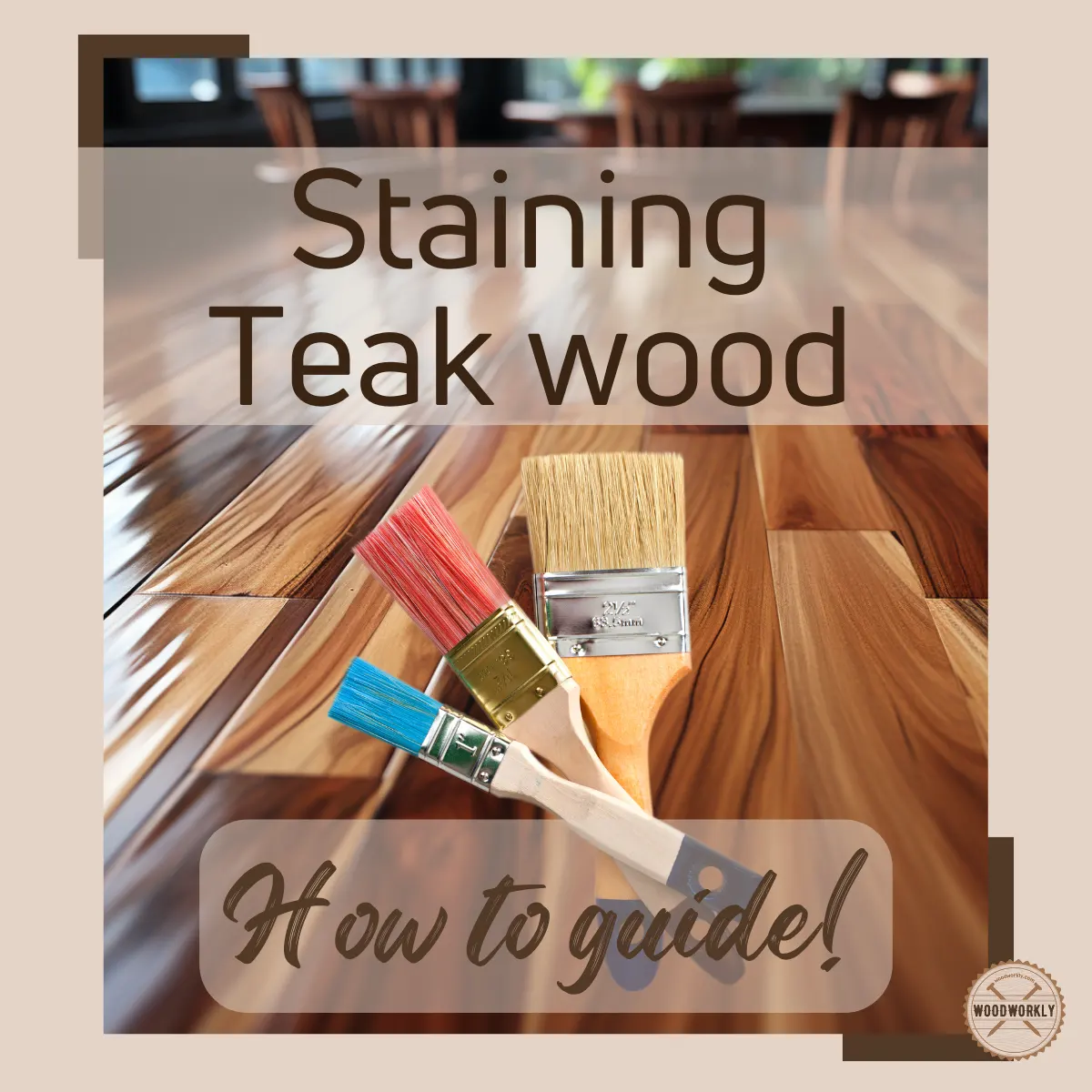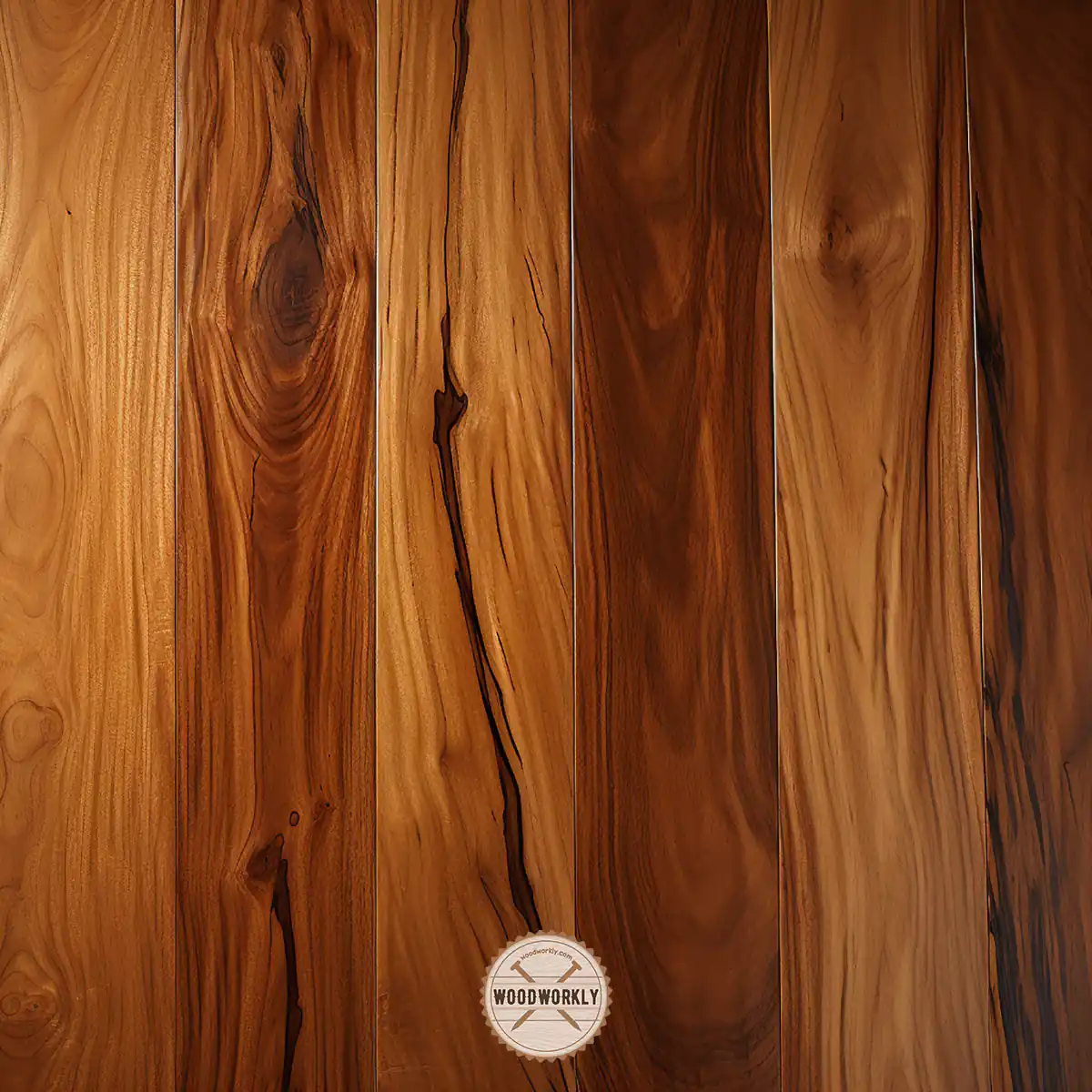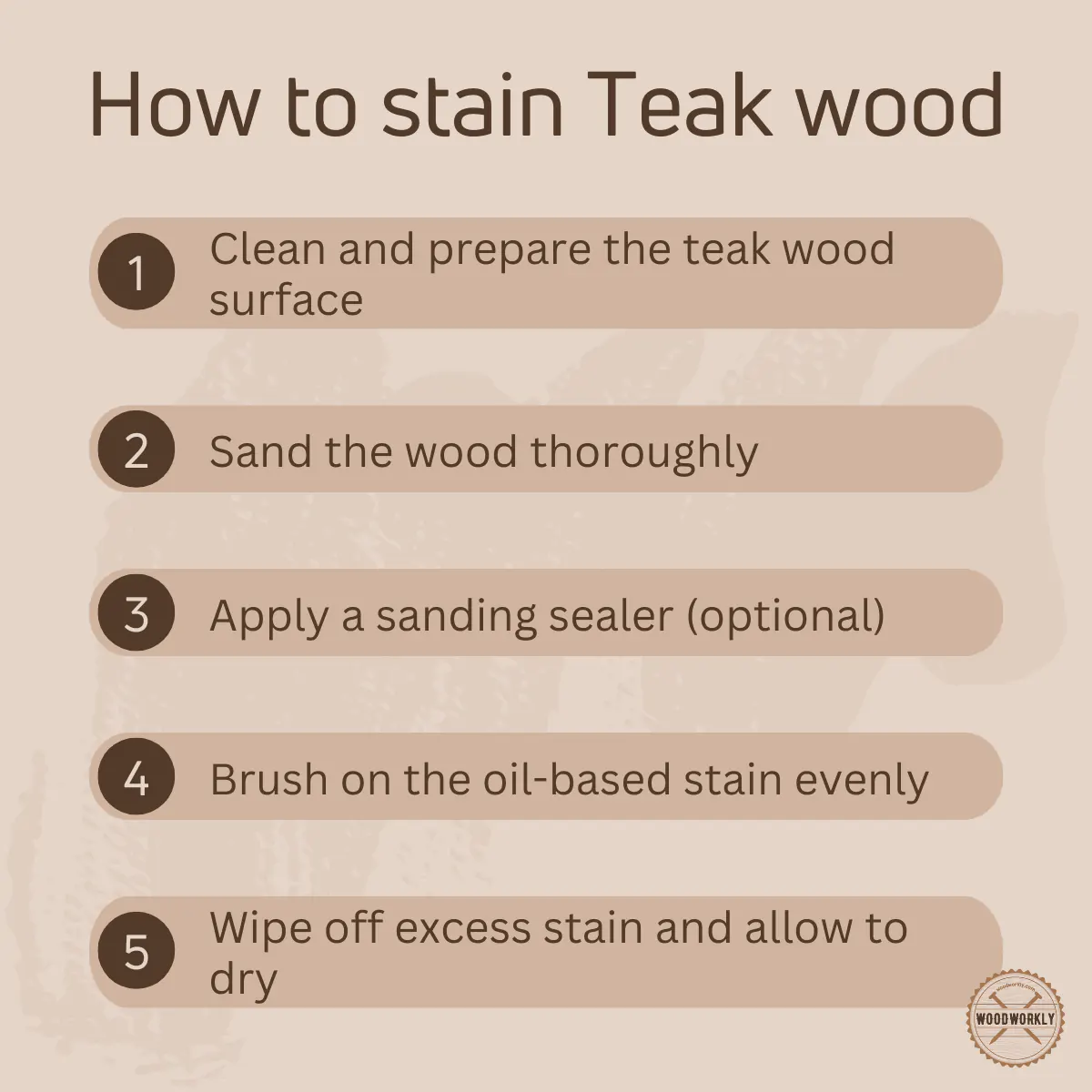Ever wondered how to elevate the natural charm of teak wood? Staining can transform it, but do you know the right way to do it? Let’s dive in!

Fixing up my mom’s special teak wood cabinet was the first time I worked with teak. That’s when I began learning about how to stain teak wood properly.
Since then, I’ve spent many years getting really good at staining teak wood. I learned so much about making this beautiful wood look its best.

Now, I’m here to share my tips and knowledge with you, so you can do great with your own teak wood staining projects.
I’ve also learned a lot from other experts who know a lot about finishing teak wood projects.
Let’s find out, Can you stain teak wood?
Yes, you can stain teak wood. To do so, first clean and sand the wood, then apply a compatible oil-based stain. Ensure even application and allow the stain to penetrate before wiping off the excess. Finish by sealing with a protective coat for durability.
But, there’s a lot to know!
In this article, I will explain teak wood, its properties, benefits, how to stain on teak surfaces in detail, and so on.
Furthermore, I’ll share some tips necessary for a successful teak wood finish and maintenance.
Let’s jump in!

Can Teak Wood be Stained?
Yes. Teak wood can be stained, but it is not generally recommended as compulsory.
Because teak wood has natural oils and a distinct grain pattern that make it naturally stain-resistant.
These natural oils aid in the protection of the wood against moisture, insects, and decay. Furthermore, when exposed to the elements, teak wood develops an appealing silvery-gray patina.
The gray faded tone is caused by evaporated oil caused by UV ray exposure. This means the wood is weaker and less resistant to moisture.
Staining is an option if you have older teak furniture that has lost its original color and want to restore it to a more natural or golden appearance. In order to do this, use a teak-specific wood stain.
It also adds an extra layer of protection against the elements, especially if it is exposed to harsh weather conditions. The stain can act as a moisture and UV ray barrier.
Wood stains have been designed to completely soak into the wood, stain it to your desired color, and bring out the beauty of the natural grain in the timber.

Benefits of Staining Teak Wood
- Teak wood staining can enhance its natural beauty by deepening the color and focusing on the grain. It can enhance the visual appeal of teak by bringing out its warm, golden-brown tones. You can get a mirrored, affordable finish.
- Teak stains come in a variety of shades and colors, allowing you to personalize the appearance of your teak wood furniture.
- Stains form a protective barrier on the wood’s surface, repelling moisture and preventing water damage such as warping, cracking, and rotting.
- Teak wood staining and finishing can help to extend the life of your furniture by protecting it from weather-related damage, which is especially important in outdoor settings.
- Many teak stains and finishes are UV resistant, which protects the wood from the damaging effects of sunlight. When exposed to sunlight, UV protection can keep the wood from fading, graying, or developing a silvery patina.
- When compared to untreated wood, stained teak wood is generally easier to clean and maintain. Stains make the surface of the wood smoother and less prone to collecting dirt and grime.
- Stains can withstand staining from a variety of substances, including food, beverages, and oils. They also help to prevent mold and mildew growth on teak wood, which is important for outdoor furniture in damp environments.

Best Stain Colors for Teak wood
The best teak wood stain color is determined by your personal preferences as well as the style of your space.
Teak wood is naturally beautiful, with a warm, golden-brown color that many people enjoy. You could use a clear teak sealer or teak oil to enhance or preserve its natural appearance.
Natural Finish: To keep the original appearance of the teak wood, choose a clear or natural teak finish. This will both protect the wood and allow its warm, golden-brown color to shine through.
Dark Brown or Walnut: Use a dark brown or walnut stain to achieve a deeper and darker finish. This can give the appearance of being more dramatic and luxurious.
A gray or weathered wood stain can help you achieve a rustic and worn-in look if you prefer a weathered or aged appearance.
A honey or golden teak stain: This can enhance the natural warm tones of teak wood, giving it a richer and more vibrant appearance.
Cherry or Mahogany: These reddish-brown stain colors can give teak wood a reddish hue by adding warmth and depth.
You also can mix different colors of wood stains to get the perfect color as you wish!

Factors To Consider When Staining Teak Wood
You need to consider the following factors when selecting a teak wood stain.
Teak Wood Type
There are various types of teak wood, and the origin of the wood can influence its natural color and characteristics. Consider the type of teak you’re using and how staining might affect it.
Desired Appearance
Consider the appearance you want to achieve. Do you want to bring out the natural color of the teak, change its color, or achieve a specific aesthetic? It is critical to understand your desired outcome.
Indoor or Outdoor Use
Consider whether your teak furniture will be used primarily indoors or outdoors, as outdoor furniture may require more durable and weather-resistant finishes.
Maintenance
Think about how much upkeep you’re willing to put up with, as some finishes may require more frequent reapplication than others.
Environmental Concerns
If you’re concerned about the product’s environmental impact, look for eco-friendly and low-VOC (volatile organic compound) alternatives.

Best Stain Product for Teak Wood
The best teak wood stain product is largely determined by your individual needs and preferences, as well as whether you want to enhance the wood’s natural appearance or change its color.
There are several teak wood stain and finish products available, each with its own set of characteristics, uses, drying times, benefits, and drawbacks.
Here are some commercially available stain products.
Premium Teak Care Kit from Star Brite
This kit usually comes with a teak cleaner, brightener, and sealer. It was created to clean, restore, and protect teak wood on boats and outdoor furniture.
Drying times vary by product, but most steps are completed within a day.
Pros
- Offers a comprehensive teak care solution.
- Teak wood is cleaned, restored, and sealed.
- Teak is suitable for marine and outdoor applications.
Cons
- Multiple steps may be needed. Therefore, it requires more effort and time than single-step procedures.

Teak Sealer Semco
Semco Teak Sealer is a protective finish that keeps the natural look of teak wood. It is appropriate for teak outdoor furniture, including boats.
Depending on environmental conditions, it dries in a few hours to a day.
Pros
- Maintains the natural color and grain of teak wood.
- Provides UV protection as well as resistance to moisture and stains.
- It requires little upkeep.
Cons
- In outdoor settings, reapplication may be required on a regular basis.
Profin Outdoor Oil by Dalys
Dalys Profin Outdoor Oil is intended to protect and improve the appearance of outdoor wood, including teak furniture.
Depending on environmental conditions, it dries in a few hours to a day.
Pros
- Enhances the natural beauty of the wood.
- Moisture resistance and UV protection are provided.
- Simple to apply and maintain.
Cons
- Reapplication may be necessary over time, especially in direct sunlight.

Watco Teak Oil
Watco Teak Oil Finish can be used on both interior and exterior teak wood. It deepens the color of the wood and protects it from moisture and UV rays.
Depending on environmental conditions, the drying time varies from a few hours to a day.
Pros
- Improves the natural color and grain of teak wood.
- It protects against moisture and UV rays.
- Simple to apply and maintain.
Cons
- Reapplication is required on a regular basis to keep the finish.
Helmsman Spar Urethane by Minwax
Minwax Helmsman Spar Urethane is a clear finish that can be used on outdoor teak wood. It offers excellent UV protection as well as moisture resistance.
Drying time varies but can range from several hours to a day.
Pros
- Provides excellent UV resistance and weather protection.
- The finish is high-gloss.
- Finish that will last.
Cons
- It can be more difficult to apply evenly.
- Over time, more maintenance may be required.

Does Teak Wood Need Wood Conditioner Before Staining?
Normally wood conditioners are used on certain woods, such as pine or wood that is soft, to prevent uneven stain absorption and blotching.
Teak is a dense hardwood that is naturally stain-resistant and absorbs stains evenly.
Therefore, teak wood doesn’t necessarily need to be conditioned and treated before staining. So you can directly apply the stain on new, untreated teak.
However, it is better to test a small, inconspicuous area first to ensure that the stain applies evenly and produces the desired result.
If you notice any uneven staining, you can use a wood conditioner designed specifically for hardwoods, but this is not a common or necessary step when staining teak wood.

Supplies You Will Need for Staining Teak Wood
First of all, gather all the tools and materials mentioned below.
- Safety gear (safety glasses, gloves, and a dust mask)
- Sandpapers or sanding pads in various grits (120- 220 grit)
- Clean cloth or tack cloth
- Wood conditioner (optional)
- High-quality teak stain
- Sanding sealer or wood filler
- Brushes and applicators
- Stir stick
- Old rags or clothes
Check out the Best Brushes For Staining Wood!
How to Stain Teak Wood?
Teak wood can be stained to improve its appearance and provide protection against the elements.
Here’s the procedure for staining teak wood.
As always safety first! Wear safety gear before starting the procedure.
Make sure your workspace is well-ventilated and to protect the work area and surroundings from drips and spills cover them with Drop cloths or plastic sheets.
Here are the steps you need to follow when staining teak wood,
- Prepare the teak surface
- Sand the surface
- Applying the sanding sealer
- Sand again the sealed surface
- Apply wood conditioner (optional)
- Apply the teak stain
- Wipe off excess stain
- Let the stain dry
- Apply additional coats (if necessary)
- Finish with a top coat (if necessary)
I’ll explain each step in detail. Keep reading.
1. Prepare the Teak Surface
The first step in preparing teak wood for staining is to thoroughly clean the surface and ensure that the surface is free of dirt and dust.
You may use a mild detergent with water for this purpose.
You can use a brush with soft bristles soaked in a dish soap and water solution to scrub the wood surface gently until the dirt is removed.
If the teak wood already has a finish, you may need to remove it using a finish remover and following the product’s instructions. Skip this step if the teak is new or unfinished.
2. Sand the Surface
Next, sand the teak wood with 120-grit sandpaper or sanding pads. Sand in the direction of the wood grain to achieve a uniform surface.
If you’re working on a small project, a handheld or portable sanding block is ideal. However, for larger projects, an orbital sander is preferable.
Remove any sanding dust from the wood surface. Wipe the surface with a tack cloth or a wet rag, then allow it to dry completely.
Sanding is essential for a smooth and nice stain surface.
3. Applying the Sanding Sealer
For this, the surface should be completely dried and dust-free. Using a foam brush, apply a sanding sealer layer.
Keep the layer thin so that it does not fill the pores but only conditions the surface to absorb the stain better.
It also allows for even pigment distribution, which results in a more balanced color.
If you need to apply a light-colored stain, you can lighten the sanding sealer by adding a small amount of mineral spirit to your sealer.

4. Sand Again the Sealed Surface
After completely drying the surface, sand it with 220-grit sanding paper.
Don’t use a power sander for this step because we need a smooth and flatten the raised grain caused by the sealer.
After you are done, wipe off all the sanding dust from the surface.
5. Apply Wood Conditioner (optional)
If you’re staining new teak wood or are concerned about blotchiness, use a wood conditioner as directed by the manufacturer. It aids in the even absorption of the stain on the wood.
6. Apply the Teak Stain
Before using, thoroughly mix the teak stain or finish with a stir stick.
Apply the stain in the direction of the wood grain with an applicator such as a foam brush, natural bristle brush, rag, or pad.
If there are things that you don’t want to stain on the surface such as glass or hardware use masking tape to mask off those areas.
Next, allow the stain to penetrate the wood for the time recommended by the manufacturer. Depending on the product and the desired color intensity, this time varies.
Your patience is key to avoiding wood stain mistakes.
7. Wipe off Excess Stain
Do this after the recommended penetration time; at least you may have to wait at least five minutes.
Wipe away any excess stains with an old rag or cloth. You can achieve a smoother finish, by wiping in the direction of the wood grain.
If you want a darker color, you must leave the stain on for a longer period. I recommend waiting a maximum of 10 minutes before wiping down the wood surface.
In contrast, if you need a lighter color, don’t leave the stain much longer. Wipe it immediately after applying within less than five minutes.
Read to know How to remove stains from your skin once the staining project is done!
8. Let the Stain Dry
Allow the stained surface to completely dry, which should take several hours or as directed on the product label.
Water-based stains typically dry in 30 minutes to an hour. Meanwhile, oil-based stains take longer to dry, sometimes several hours.
9. Apply Additional Coats (if necessary)
Apply additional coats of stain, allowing each coat to dry in between, to achieve a deeper color. Usually, 2-3 coats are enough.
Since stains lighten as they dry. If you want a darker color, you must apply a second stain coat, following the same procedure as the first.
10. Finish with a Top Coat (if necessary)
After the stain has dried completely, apply a clear finish such as varnish, lacquer, and polyurethane or teak oil as a top coat for added protection.
For this, you need to follow the manufacturer’s instructions.

Maintenance and Care Tips for Stained Teakwood Furniture
It is critical to maintain and care for stained teakwood furniture in order to keep its appearance and longevity.
Here are some tips for maintaining and caring for your stained teakwood furniture.
Cleaning Regularly
To remove surface dirt and debris, dust the furniture on a regular basis with a soft, dry cloth or a feather duster.
Abrasive cleaners, harsh chemicals, and power washers should be avoided because they can damage the finish and the wood.
Cleaning Periodically
Use a mild soapy water solution (dish soap or a teak-specific cleaner) and a soft brush or sponge. Scrub the surface gently, then rinse with clean water and thoroughly dry it.
Furthermore, you can mix a cup of bleach and a scoop of laundry detergent with a gallon of warm water to gently scrub the surface.
Instead of the above solution, you can mix a cup of vinegar in a gallon of warm water to gently scrub the surface. After scrubbing, thoroughly rinse with clear water.
If your teak furniture has an oiled finish, you can apply teak oil on a regular basis to keep the wood hydrated and maintain its natural appearance.
Follow the manufacturer’s recommended oiling schedule.
UV Shielding
To reduce UV damage, use furniture covers or place your stained teak furniture in a shaded area if it is exposed to direct sunlight.
UV protection can be provided by stains and finishes, but the sun can still cause gradual color changes over time.
Additionally, you can,
- Lift rather than drag teak furniture when moving it to avoid scratches and damage to the legs or feet.
- Put furniture pads or glides under the legs to protect both the furniture and the surface it sits on.
- Consider storing outdoor teak furniture indoors or using furniture covers, during harsh weather conditions, such as winter or heavy rain.
- Inspect your furniture on a regular basis for signs of damage, loose joints, or finish wear. Address any issues as soon as possible to avoid further damage.
- Refinish it if the finish begins to wear or you want to change the appearance of the furniture.
By following the above maintenance and care tips, you can ensure that your stained teakwood furniture stays in good condition and looks beautiful for many years.

How Frequent Should You Stain Teak Wood Furniture And Fences?
Reapplying stain to your teak wood furniture, fences, decks, and other outdoor structures every 5 years.
However, it is always dependent on the type and quality of the stain used. The application process can also affect the stain’s longevity.
If applied correctly, the wood stain can last up to seven years before needing to be reapplied to your outdoor furniture and structures.
Why Is Treating Outdoor Furniture Important?
If unprotected and exposed to harsh weather conditions, teak wood will eventually lose its natural oil content and although you apply oil the damage can’t be reversed.
Teak oil can be extremely damaging to outdoor furniture and fences for a variety of reasons. Teak oil can make the wood brittle, and it will not reverse weathering effects.
Teak oil, in some cases, promotes mold and mildew growth by interfering with the wood’s natural moisture-resistant properties.
Read to learn How to paint teak wood properly!
That’s it, folks! Now you know all about staining teak wood with all its properties and finishing techniques.

So, let’s answer some frequently asked questions.
FAQs
Do I Need to Sand Teak Wood Before Staining?
Sanding teak wood is crucial before staining, especially if it’s aged and has turned silver-gray, to ensure even stain absorption and a smooth finish.
What Type of Stain is Best for Teak Wood?
Oil-based stains are often recommended for teak wood due to their compatibility with the wood’s natural oils and ability to penetrate its dense grain.
How Long Should Stain Sit on Teak Wood?
The duration stain should sit on teak wood varies by product, but typically, a longer sitting time results in a darker finish.
Is Sealing Teak Wood Necessary After Staining?
Sealing teak wood after staining is advisable to protect the stain and wood, with options including polyurethane for water resistance or oil finishes for a natural look.
Can I Stain Weathered Teak Wood?
Yes, weathered teak wood can be stained, but it requires thorough preparation such as cleaning and sanding to revive its appearance.
How Do I Maintain Stained Teak Wood?
Maintaining stained teak wood involves regular cleaning with mild soap and water, periodic reapplication of stain or sealer, and protection from harsh weather conditions.
Does Staining Teak Wood Change Its Natural Color?
Staining teak wood alters its natural color, enhancing or modifying its appearance based on the chosen stain color.
Can I Use a Water-Based Stain on Teak Wood?
Water-based stains can be used on teak wood, but they may raise the grain slightly and typically require a finish coat for protection.
How Often Should I Restain Teak Wood?
The frequency of restaining teak wood depends on exposure to elements and wear, but generally, it might be necessary every 5 to 7 years.
Did I cover all you wanted to know about: Staining Teak Wood
In this article I deeply explored can you stain teak wood and how to do that properly using the right techniques recommended by the experts.
Staining teak wood enhances its aesthetic value, while also providing color customization and UV protection. It also protects against moisture, extending the life of the wood and making maintenance easier. Oil-based stains will last longer than water-based stains. However, applying teak oil won’t reverse the damage.
Furthermore, I answered some frequently asked questions as well.
Hope you learned everything you wanted to know about, staining teak wood including experts’ tips.
Now let’s this method a try and enhance your teak wood furniture like a champ!